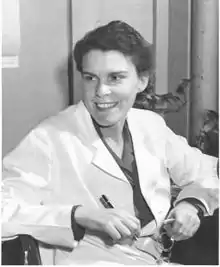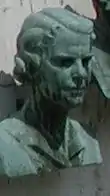Isabel Morgan
Isabel Merrick Morgan (also Morgan Mountain) (20 August 1911 – 18 August 1996) was an American virologist at Johns Hopkins University who prepared an experimental vaccine that protected monkeys against polio in a research team with David Bodian and Howard A. Howe.
Isabel Merrick Morgan | |
|---|---|
 | |
| Born | October 20, 1911 |
| Died | October 18, 1996 (aged 84) |
| Nationality | American |
| Alma mater | |
| Known for | Research into polio immunization |
| Scientific career | |
| Fields | Virologist |
| Institutions | |
Early life and education

Isabel Merrick Morgan was born 20 August 1911. Her parents were Thomas Hunt Morgan and Lilian Vaughan Sampson. Morgan graduated from Stanford University and wrote her doctoral thesis in bacteriology at the University of Pennsylvania.
Career and research
She joined the Rockefeller Institute for Medical Research in New York in 1938. There she worked in Peter Olitsky's lab and did research work on immunity to viral diseases, such as polio and encephalomyelitis.[1][2]
In 1944, Morgan joined a group of virologists, including David Bodian, at Johns Hopkins. Her work led to the identification of three distinct serotypes of poliovirus, all of which must be incorporated for a vaccine to provide complete immunity from poliomyelitis.[3] She also began experiments to immunize monkeys against polio with killed poliovirus grown in nervous tissue and inactivated with formaldehyde. After vaccination with the inactivated virus, the monkeys were able to resist injections with high concentrations of live poliovirus.[4] Maurice Brodie had demonstrated the same induction of immunity with inactivated virus in 1935.[5]

Morgan's work was a key link in the chain of progress toward a killed-virus polio vaccine, one that culminated in the approval of Jonas Salk's vaccine for general use in 1955. Until Morgan did her work, it was believed that only live viruses could convey immunity to polio.
Later life
In 1949, Morgan left Johns Hopkins and married former Air Force Colonel Joseph Mountain, who was a data processor in New York. The couple moved to Westchester County and Morgan took a job with the county's Department of Laboratory Research.
After her marriage, Morgan never returned to polio research. She did, however, publish articles on polio.[7] When her stepson Jimmy Mountain was killed in an air crash in 1960, she gave up her job at the County Department and pursued a master's degree in biostatistics from Columbia University. She went on to work as a consultant at the Sloan-Kettering Cancer Institute in Manhattan.[8]
Morgan died in 1996, two days before her 85th birthday.
Awards
In January 1958, she was inducted into the Polio Hall of Fame at Warm Springs, Georgia. She was and remains the only woman who was so honored for her research work.
References
- Oshinsky, pages 130-133
- The Journal of Experimental Medicine (JEM), Vol 76 (1942), pp. 357–369
- Algorri, Rita (August 9, 2019). "Forging the Trail for Polio Vaccination: Isabel Morgan and Dorothy Horstmann". American Society for Microbiology. Retrieved 2020-12-08.
- MORGAN IM. Immunization of monkeys with formalin-inactivated poliomyelitis viruses. Am J Hyg. 1948 Nov;48(3):394-406. PubMed PMID 18893238
- Maurice Brodie. Active Immunization in Monkeys Against Poliomyelitis with Germicidally Inactivated Virus. Immunol January 1, 1935, 28 (1) 1-18
- Furman, Bess (January 3, 1958). "New Hall of Fame Hails Polio Fight". The New York Times. Retrieved April 8, 2020.
- where she appears as Isabel Morgan Mountain, PhD, as can be seen in The Journal of Experimental Medicine (JEM), Vol 108 (1958), pp. 505f.
- "Isabel Morgan | American Experience | PBS". www.pbs.org. Retrieved 2020-12-08.
Further reading
- David Oshinsky: Polio: An American Story. Oxford University Press, 2005 ISBN 0-19-515294-8.
- Allen, Garland E. (1978). Thomas Hunt Morgan: The Man and His Science. Princeton University Press. ISBN 0-691-08200-6.